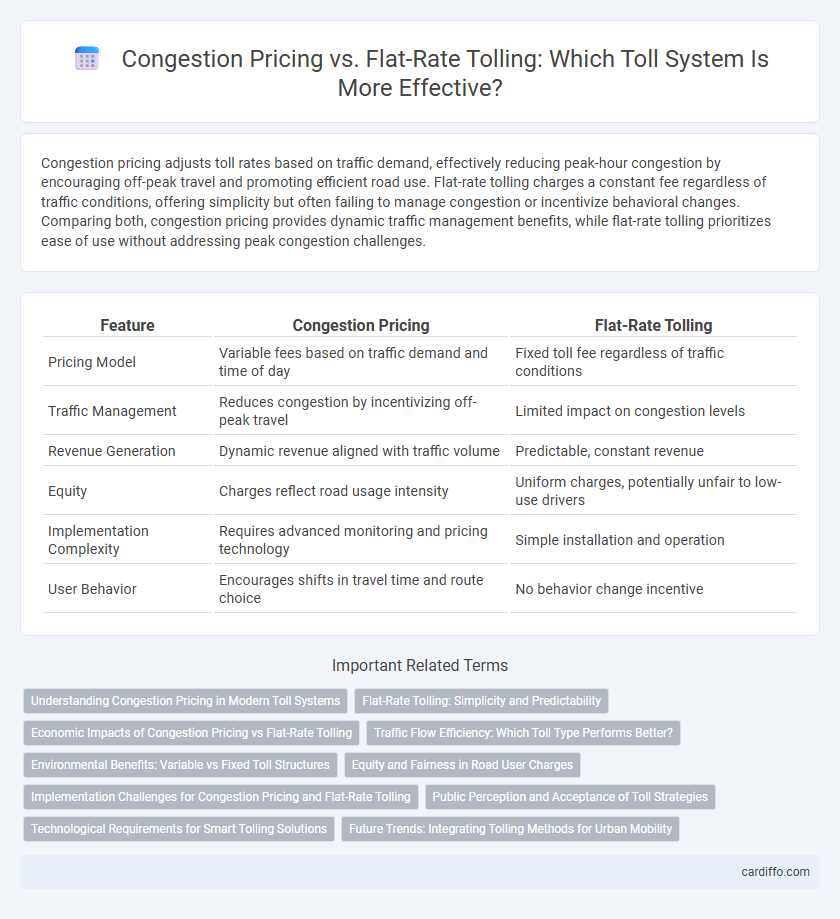Congestion pricing adjusts toll rates based on traffic demand, effectively reducing peak-hour congestion by encouraging off-peak travel and promoting efficient road use. Flat-rate tolling charges a constant fee regardless of traffic conditions, offering simplicity but often failing to manage congestion or incentivize behavioral changes. Comparing both, congestion pricing provides dynamic traffic management benefits, while flat-rate tolling prioritizes ease of use without addressing peak congestion challenges.
Table of Comparison
| Feature | Congestion Pricing | Flat-Rate Tolling |
|---|---|---|
| Pricing Model | Variable fees based on traffic demand and time of day | Fixed toll fee regardless of traffic conditions |
| Traffic Management | Reduces congestion by incentivizing off-peak travel | Limited impact on congestion levels |
| Revenue Generation | Dynamic revenue aligned with traffic volume | Predictable, constant revenue |
| Equity | Charges reflect road usage intensity | Uniform charges, potentially unfair to low-use drivers |
| Implementation Complexity | Requires advanced monitoring and pricing technology | Simple installation and operation |
| User Behavior | Encourages shifts in travel time and route choice | No behavior change incentive |
Understanding Congestion Pricing in Modern Toll Systems
Congestion pricing in modern toll systems dynamically adjusts fees based on real-time traffic volumes to reduce road congestion and optimize traffic flow. Unlike flat-rate tolling, which charges a fixed fee regardless of traffic conditions, congestion pricing incentivizes drivers to travel during off-peak hours or use alternative routes, effectively managing demand. Data from cities implementing congestion pricing, such as London and Singapore, demonstrate significant reductions in peak-hour traffic and improvements in overall travel efficiency.
Flat-Rate Tolling: Simplicity and Predictability
Flat-rate tolling offers simplicity by charging a uniform fee regardless of traffic conditions, making it easier for drivers to anticipate costs without monitoring fluctuating rates. This predictable structure reduces administrative complexity and enhances user convenience, fostering consistent revenue streams for highway maintenance. Unlike congestion pricing, flat-rate tolling avoids real-time adjustments, ensuring straightforward implementation and public acceptance.
Economic Impacts of Congestion Pricing vs Flat-Rate Tolling
Congestion pricing generates significant economic benefits by reducing traffic delays and vehicle operating costs, leading to increased productivity and lower emissions compared to flat-rate tolling. Flat-rate tolling provides predictable revenue but lacks the efficiency incentives to reduce peak-hour congestion, often resulting in persistent traffic and higher external costs. Implementing congestion pricing optimizes road usage, encourages off-peak travel, and supports dynamic demand management, boosting overall economic welfare.
Traffic Flow Efficiency: Which Toll Type Performs Better?
Congestion pricing dynamically adjusts toll rates based on real-time traffic volume, effectively reducing peak-hour congestion and improving overall traffic flow efficiency by encouraging drivers to travel during off-peak times or use alternative routes. Flat-rate tolling, while simpler to administer, often fails to curb traffic demand during congested periods, leading to slower speeds and increased delays. Studies from urban areas like London and Singapore demonstrate that congestion pricing outperforms flat-rate tolling in managing traffic density and enhancing roadway performance.
Environmental Benefits: Variable vs Fixed Toll Structures
Congestion pricing reduces vehicular emissions by charging higher tolls during peak traffic, encouraging drivers to shift travel times or use alternative transport, leading to decreased air pollution and greenhouse gas emissions. Flat-rate tolling lacks this dynamic incentive, often resulting in constant traffic volumes and stable emission levels regardless of congestion. Studies show cities implementing variable toll structures experience significant improvements in air quality and reductions in carbon footprints compared to those with fixed-rate toll systems.
Equity and Fairness in Road User Charges
Congestion pricing promotes equity by charging drivers based on real-time traffic conditions, encouraging off-peak travel and reducing road congestion for all users. Flat-rate tolling applies a uniform fee regardless of demand, potentially burdening low-income drivers who cannot adjust travel times. Implementing congestion pricing with targeted rebates or discounts enhances fairness by distributing costs according to road usage and ability to pay.
Implementation Challenges for Congestion Pricing and Flat-Rate Tolling
Congestion pricing implementation faces challenges such as the need for advanced technology to monitor traffic flows in real-time and address equity concerns among low-income drivers affected by variable charges. Flat-rate tolling struggles with inefficiencies, as it fails to influence travel behavior during peak hours and requires extensive infrastructure to manage consistent fee collection across all vehicles. Both systems demand careful integration with existing transportation networks to minimize disruption and ensure public acceptance.
Public Perception and Acceptance of Toll Strategies
Public perception of congestion pricing often reflects concerns about fairness and the impact on lower-income drivers, whereas flat-rate tolling is generally seen as more straightforward and equitable. Congestion pricing tends to gain acceptance when clear benefits, such as reduced traffic and improved air quality, are effectively communicated to the public. Studies show that transparent use of toll revenues for infrastructure improvements enhances public trust and willingness to support variable toll strategies.
Technological Requirements for Smart Tolling Solutions
Congestion pricing demands advanced real-time traffic monitoring systems, dynamic pricing algorithms, and robust communication networks to adjust toll rates based on traffic flow and congestion levels. Flat-rate tolling requires simpler technology, primarily including fixed-rate billing systems and basic vehicle detection equipment for entry and exit verification. Smart tolling solutions integrate GPS, automated vehicle identification, and cloud-based data processing to enable seamless, scalable, and efficient toll collection adaptable to varying traffic conditions.
Future Trends: Integrating Tolling Methods for Urban Mobility
Future trends in urban mobility indicate a shift toward integrating congestion pricing with flat-rate tolling to optimize traffic flow and reduce emissions. Dynamic pricing models powered by real-time data analytics adjust toll rates based on traffic density, while flat-rate tolling ensures predictable costs for regular commuters. This hybrid approach supports sustainable urban transportation by balancing financial incentives with equitable access.
Congestion Pricing vs Flat-Rate Tolling Infographic

 cardiffo.com
cardiffo.com